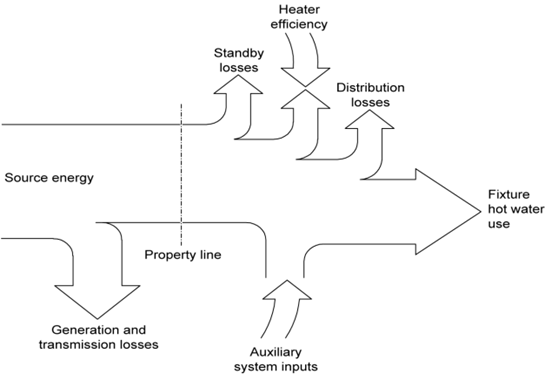
Chapter 5 describes the compliance requirements for domestic water heating for newly constructed residential dwellings, including single-family, and low-rise (three or fewer habitable floors) multifamily buildings. This chapter also describes common water heater types, best practices for water heater maintenance, hot water distribution system designs, and examples of commonly asked questions regarding compliance with Energy Standards requirements. For general information about compliance and enforcement please see Chapter 2 of this compliance manual. For information about water heating requirements for additions and alterations, please see Chapter 9.
This section summarizes changes to the requirements for residential water heating for the 2019 Energy Standards. Please see Sections 5.3 and 5.4 for detailed information on the mandatory and prescriptive water heating requirements in the 2019 Energy Standards.
5.1.1.1 Mandatory Requirements
1. Requirement for temperature controls in public lavatories has been removed to align with plumbing code.
2. The high efficiency water heater ready requirement for electrical receptacle has been updated to require the receptacles to be dedicated and connected to a 120/240 volt 3 conductor, 10 American Wire Gauge (AWG) branch circuit. This change allows easier and cheaper installation of heat pump water heater as a replacement.
5.1.1.2 Prescriptive Requirements
Significant changes to the 2019 prescriptive requirements for single-family buildings and multifamily buildings with a dedicated water heater in each dwelling unit include the following:
1. Heat pump water heaters were added as a possible prescriptive path option.
2. Drain water heat recovery was added as a possible prescriptive path option.
3. Hot water pipe insulation was removed since it is now required under the California plumbing code. (A Home Energy Rating System [HERS] verified pipe insulation remains as a compliance option)
4. The maximum input rating for gas storage water heaters over 55 gallons was reduced to 75,000 British thermal unit per hour (Btu/Hr) to better align with U.S. Department of Energy (DOE) classification.
Significant changes to the 2019 prescriptive requirements for multifamily buildings with a central water heating system include the following:
1. Drain water heat recovery can be used to reduce the required solar savings fraction of the solar thermal system.
5.1.1.3 Performance Compliance Method
When the performance compliance method is used, the water heating energy budget now has an independent gas or electric baseline based on the proposed water heater type. For gas type water heaters, the energy budget is based on the performance of a gas instantaneous water heater. For electric water heaters, the energy budget is based on the performance of a heat pump water heater with compact hot water distribution and a drain water heat recovery device. Both gas and electric water heaters used in the baseline meet the minimum requirements in California’s Title 20 Appliance Efficiency Regulations Section 1605.1(f) for federally regulated appliances. For more information, see Section 5.5.
Table 5-1 provides an overview of the location of the water heating requirements in the 2019 Energy Standards by construction and building type.
|
Type |
Mandatory Requirements |
Prescriptive Requirements |
Performance Requirements | |||
|
Standards Section |
Manual Section |
Standards Section |
Manual Section |
Standards Section |
Manual Section | |
|
Single-family home – Newly built |
§150.0(j|topic=(j) Insulation for Piping and
Tanks. |
5.3 |
i, ii, iii, iv, v |
5.4.1 |
|
5.5 |
|
Single-family home – Addition |
5.3, 9 |
5.4.1 |
|
5.5 | ||
|
Single-family home – Alteration |
5.3, 9 |
5.4.1 |
|
5.5 | ||
|
Multi-family – Newly built individual dwelling units |
5.3 |
5.4.2 |
|
5.5 | ||
Total energy use associated with water heating consists of the end use, heater inefficiencies, standby loss, and distribution system inefficiencies. Figure 5-1 below shows the energy flows that constitute water heating energy usage. Hot water draws at the end use points (for example, faucets, showers, and so forth) represent the useful energy consumed. In most cases, hot water that is actually used represents the largest fraction of water heating energy use, although in situations when there are very few hot water draws, standby losses from a standard gas storage water heater and the hot water distribution system can exceed the quantity of useful energy consumed at the end point. Energy impacts associated with the hot water distribution system vary widely based on the type of system, quality of insulation and installation, building and plumbing design, and hot water use patterns. Distribution losses in a typical single-family home may be as much as 30 percent of the total energy used for water heating. Distribution losses in single-family homes with compact hot water distribution systems may be lower than 10 percent of total water heating energy use. In a typical multifamily building, distribution losses can account for more than 30 percent of total water heating energy use. An important consideration for any water heating system is the recovery load (that is, end use plus distribution losses) of the water heating unit minus any contribution from auxiliary heat inputs, such as a solar thermal system.
Figure 5-1: Water Heating Energy Flow Representation
